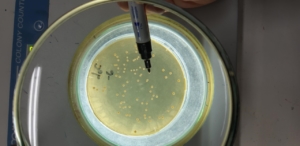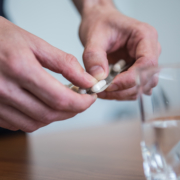How do probiotics stay alive until they are consumed?
By Prof. Gabriel Vinderola PhD, Associate Professor of Microbiology at the Faculty of Chemical Engineering from the National University of Litoral and Principal Researcher from CONICET at Dairy Products Institute (CONICET-UNL), Santa Fe, Argentina
See the Spanish version of this blog post here.
As a professor, most of my days are spent with people from the academic and scientific world. But through some outreach activities, I am also fortunate to interact with many people who are not scientists by training, but have curious, scientific minds. One question I am often asked is, “Is it really possible for probiotics to still be alive when they are dried and in a capsule?” The answer is yes. Let me provide some basic background on probiotics and explain my response.
The idea of consuming live microbes to promote health is not new. Back in 1907, Élie Metchnikoff, a disciple of Louis Pasteur, the father of microbiology, associated the intake of fermented milks containing live lactobacilli, with a prolonged and healthy life in Bulgarian peasants (see here). This idea was later captured by the concept of probiotics: live microorganisms that, when administered in adequate amounts, confer a health benefit on the host (Hill et al. 2014). Four simple and pragmatic criteria allow one to conclude if specific strains of microorganisms qualify as a probiotic for use in foods and dietary supplements. Probiotic strains must be (i) sufficiently characterized; (ii) safe for the intended use; (iii) supported by at least one human clinical trial showing they are effective; and (iv) alive in the product at an efficacious dose throughout shelf life (Binda et al. 2020). Being alive at the moment of consumption is one of the key characteristics of probiotics.
Life is the condition that distinguishes animals and plants from inorganic matter. Life includes the capacity for growth, for reproduction and for metabolic activity. In order to sustain life, certain environmental conditions must be met, but these differ for different organisms. For microbes, the availability of water and nutrients, adequate temperature and pH (acidity), and the absence of growth inhibitors are essential conditions. However, it is possible to manipulate certain conditions to bring about a state where growth may be put in “stand-by mode”, yet the microbe remains alive. We cannot imagine ourselves in a condition where life is preserved even without any metabolic activity, but for microbes it is possible. Probiotics can be in foods (yoghurts, fermented milks, fruit juices, cereal bars) or in food supplements (capsules, compressed pills) in a “hibernation” state, characterized by no growth, no reproduction and no metabolic activity, waiting for the proper conditions to come back to full metabolic life. This occurs when the microbes reach the gut, which has proper temperature, nutrient availability, lack of inhibitors, adequate acidity and water. Thus, in case of microbes, there is an uncoupling of life and metabolic activity. Even without having any metabolic activity, they can still be alive, but in a dormant state.
Open a food supplement containing probiotics and you will probably find a white dry powder. This is what the microbes may look like in their dormant state, due to a technological process called freeze-drying or lyophilization. Freeze-drying is a two-stage process where cells are first quickly frozen at very low temperatures (-40 to -70°C, or less, using liquid nitrogen for example). Then, frozen water is removed by a gentle process of evaporation at low pressure and temperature, called sublimation. This process removes most of the water from around and inside the cells, leaving the microbes in a dormant state. Water activity is scientists’ way of measuring water availability for the microbes. This technological measure ranges from 0 (no water) to 1 (pure water). A water activity close to 0 impairs growth. In food supplements, freeze-drying leaves water activities less to 0.2, ensuring that no metabolic activity will take place during the shelf life of the product.

Bifidobacteria cells (circled in red) freeze-dried in a probiotic powder. This is a scanning electron microscopy image amplified 10,000 times. Cells are embedded in dry polydextrose.
So yes, probiotics in food supplements are alive in their own way. This is the case also for probiotics included in certain foods such as cereal bars. In case of food products with water activities closer to 1, such as yogurts, fermented milks, cheeses or fruit juices containing probiotics, the factor that limits metabolic activity is the low temperature at which these products are stored, combined in certain cases (yogurts, fermented milks, fruit juices) with the low pH (or high acidity) of these products. The combination of low temperature and acidity is effective in maintaining probiotic cells in a dormant state, impairing any metabolic activity that may lead to cell stress and cell death along the shelf life of the product. Yet, even while tightly controlling factors that impair metabolic activity, some cell death may occur during the shelf life of probiotics in the products that deliver them. In this case, responsible manufacturers are sure to add extra probiotic cells so that the necessary amount of viable cells needed to deliver a health effect are present through the end of the shelf life of the product.
In both probiotic foods and food supplements, the number of viable cells is commonly expressed as a certain number of colony forming units, or by the abbreviation “CFU”. As probiotics are present in high concentrations, the number of viable cells often reaches into the billions within a capsule or in a serving of yogurt. To be able to count such enormous numbers of cells, microbiologists must make serial dilutions of the probiotic product. Then, they will put a small drop of a dilution on the surface of a Petri dish containing a culture medium on which probiotics will grow. Each probiotic cell (or clump of cells) will grow in place and form a visible colony that can be observed to the naked eye, and counted.

Agar plate containing colonies of a probiotic bacteria. Cells deposited on the surface of the agar plate duplicated several times until forming a visible amount of cells: a colony.
In brief, live probiotics are present in food and supplements, but in a state of life different to that of higher organisms where metabolic activity is taking place at all times. During shelf life, the metabolic activity of probiotics is stopped by freeze-drying them (food supplements) or by a combination of low temperature and acidity (yogurts and fruit juices, for example). Active growth returns when these microbes enter out gut and find the proper conditions of nutrients, temperature, acidity and water to be active and deliver their health effects.





